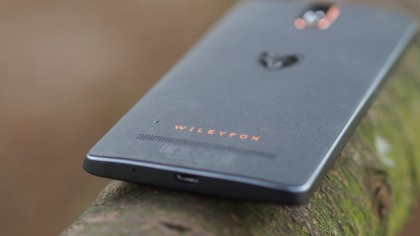Why you can trust TechRadar
The Qualcomm Snapdragon 615, along with a healthy 3GB of RAM, keeps the WileyFox Storm chugging through daily tasks with aplomb.
Whether it was swiping through the home screens, using the internet, watching a movie, or playing a graphically intensive game, I found there was little that the Storm couldn't handle.
These results are backed up by the Geekbench 3 scores. Although the Snapdragon 615 sits firmly in the middle of Qualcomm's chip lineup for 2015, and is being replaced with the 617, it's nonetheless a very capable performer.

With a single-core performance of 655, and a multi-core score of 2613, the device sits comfortably close to the Samsung Galaxy S4 for the former, and the Nexus 5 for the latter.
To achieve performance that, two years ago, was at flagship level is quite something, and for most users the power ought to be sufficient, give or take a little lag and a few dropped frames here and there.
3GB of RAM also proved to be more than sufficient for the needs of the device and ought to keep power-hounds happy, with the WileyFox Storm being able to juggle many apps simultaneously, if not quite as many as the beastly Asus ZenFone 2.
Music and video
With 32GB of built-in storage, and the option to add to this via microSD card, music lovers have plenty of space to play with on the Wileyfox Storm. And generally, the listening experience is rather nice.
Sign up for breaking news, reviews, opinion, top tech deals, and more.
As is the trend on many Android devices the Storm lacks a dedicated music app, with users having to either download a dedicated app for local playback from the Google Play Store, or use Google Play Music.

The latter option isn't particularly welcome, as while Google will happily let you play songs I found paid options being pushed at me with annoying regularity, something that hindered the overall experience a little.
On the plus side the WileyFox Storm does have a couple of impressive features for music lovers, one of which is the speaker setup.

Although the Storm can't hope to match the clarity of the HTC One M9, or the sheer volume of the Nexus 6, I found nonetheless that it could fill a room with warm tones rather nicely. Notably it didn't sound too tinny, even when really pumping out music to the best of its ability.
The second feature I enjoyed was the built-in equaliser. Tying into the wider theme of granular control, you can choose from various presets or simply adjust the sliders to taste.
Particularly when switching from bass-heavy tunes to, say, folk music, I found that it made a world of difference, especially when paired with a decent set of earphones.
As with music there's no dedicated video player on the WileyFox Storm, which is disappointing given the potential of the screen for media consumption.

Play Movies – another gateway to paid content – is the sole video player available upon installation, necessitating the installation of the likes of VLC Player for those wanting to watch their media on the go.
That said, the accurate colours of the screen, along with the aforementioned sound quality, makes for an enjoyable viewing experience.
Calls and internet
The experience of making and receiving calls benefits from the strong call speakers and decent noise cancellation; I was able to hear people I was talking with clearly, and they remarked that my voice came through loud and clear.

As a 4G-capable device, the Storm is capable of stellar download speeds, depending on the reception available in a given area. GPS performance was also adequate, achieving a lock quickly and accurately and maintaining it successfully.
Battery life
Despite having some excellent specifications for the price, there was one aspect of the Wileyfox Storm that I was somewhat apprehensive about.
For the size of the display, I was worried that the 2500mAh, non-removable battery would prove to be the handset's Achilles heel. And after a week of use, battery performance is something of a mixed bag.
One of the key advantages of phablets is the extra space that the large display affords, and typically manufacturers usually make use of this extra room by fitting an extra-high-capacity battery unit.
Unfortunately, the Storm possesses exactly the same battery unit as its smaller brother, the Swift – and while the user can replace the battery in the Swift, they can't do so in the Storm.

This is worrying, particularly given that the Storm is aimed at power users. The facility to swap the battery in order to keep going through a busy day, on the move and with few opportunities for charging, is indispensable for many users, and its absence here is frustrating.
However, with the efficient Snapdragon 615 keeping everything chugging along, I found that the battery life of the Wileyfox Storm was generally acceptable, if not excellent.
Cyanogen is something of a complication in this regard, offering just two battery modes: one that optimises performance, and one that dumbs the phone down a little to eke out extra juice.
On a typical day, waking up at around 8am, playing maybe 20 minutes of Temple Run on the bus, listening to music for around an hour, watching a few videos, browsing the internet intermittently and sending and receiving texts and emails throughout the day, I found that I had around 15% charge left by 10pm.
On one occasion though, I found that the device lost 60% of its charge during the course of an evening. Generally the battery performance of the Storm, while not reaching the heights of, say the Moto X Play, is okay, if a little inconsistent.
Sean is a Scottish technology journalist who's written for the likes of T3, Trusted Reviews, TechAdvisor and Expert Reviews.
